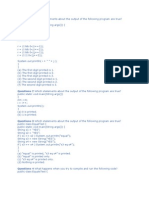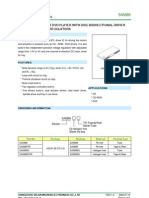CSCI 201L Written Exam #2 Summer 2016 10% of Course Grade
CSCI 201L Written Exam #2 Summer 2016 10% of Course Grade
Uploaded by
John MathiasCopyright:
Available Formats
CSCI 201L Written Exam #2 Summer 2016 10% of Course Grade
CSCI 201L Written Exam #2 Summer 2016 10% of Course Grade
Uploaded by
John MathiasOriginal Description:
Original Title
Copyright
Available Formats
Share this document
Did you find this document useful?
Is this content inappropriate?
Copyright:
Available Formats
CSCI 201L Written Exam #2 Summer 2016 10% of Course Grade
CSCI 201L Written Exam #2 Summer 2016 10% of Course Grade
Uploaded by
John MathiasCopyright:
Available Formats
Final Score _______________
Name ____________________________ ID __________________________ Extra Credit _______________
Section (circle one): MW 3:30-6:30
CSCI 201L Written Exam #2
Summer 2016
10% of course grade
1. Anonymous Inner Classes – In lecture we walked through the following:
1. Having two classes in different file.
2. Having two classes in the same file.
3. Having one class with the second class inside of it (an inner class).
4. Having one class with the second class inside of one of the methods.
5. Having one class with the second class inside the parameter call to a method with
no name (anonymous inner class).
a. Give two reasons why a programmer would choose to create an anonymous
inner class (#5 above) instead of an inner class inside of a method (#4 above).
(0.5% + 0.5%)
Reason #1
Reason #2
b. Give two reasons why a programmer would choose to create a class in a
different file (#1 above) instead of a class in the same file as another class (#2
above). (0.5% + 0.5%)
Reason #1
Reason #2
CSCI 201L Final – Written
Summer 2016
1/6
2. JDBC – JDBC uses reflection to help facilitate Java’s motto of “write once, run
anywhere.
a. Explain what reflection is. (0.5%)
b. Even though Java tried to create its JDBC framework so that no code has to be
changed when you change from one database to another, the implementation
unfortunately does not allow this. Explain why. (0.5%)
3. Networking Theory – You have started a small web hosting company and you need
to get the network set up with many Internet-facing computers. Since you have taken
CSCI 201, you know that the best way to do this is to have a static IP address on each
of those servers. Assume that you need 27 IP addresses. When you call your ISP,
there is a UCLA alumnus working there. You tell him what you want, and he says,
“One of your IP addresses is 215.76.194.57,” but he doesn’t tell you anything else.
Because you went to USC, you can hopefully answer the following questions though.
IP – 1101 0111 0100 1100 1100 0010 0011 1001
a. What is the network address? Provide this in the dotted IP notation, not in
binary. (0.5%)
b. So that you are given the fewest number of IP addresses for your desired
purpose, what is the subnet mask? Provide this in the dotted IP notation AND
slash notation, not in binary. (0.5% + 0.5%)
c. What is the network/subnet address combination? (0.5%)
CSCI 201L Final – Written
Summer 2016
2/6
4. Databases and SQL – Answer the following questions concerning the database
below.
Here is the Book table.
Here is the User table. Here is the CheckedOut table.
a. Write the SQL query that returns the following table. (1.0%)
CSCI 201L Final – Written
Summer 2016
3/6
5. Locks and Conditions – Answer the following questions about locks and
conditions.
a. The type of lock we used in Java was called a ReentrantLock. Explain
what a ReentrantLock is and how it is different from a lock that is no
reentrant. (0.5%)
b. Describe a problem that could arise if a method on a condition was able to be
called without first having the lock associated with it. (0.5%)
CSCI 201L Final – Written
Summer 2016
4/6
6. Multithreading – Give three rules that will always be true about the output of the
following program. (0.5% + 0.5% + 0.5%)
import java.util.ArrayList;
import java.util.concurrent.Semaphore;
public class Problem6 extends Thread {
public static ArrayList<Integer> al = new ArrayList<Integer>();
public static Semaphore sem = new Semaphore(2);
private int num;
public Problem6(int num) {
this.num = num;
}
public void run() {
try {
sem.acquire();
System.out.println(num + " starting ");
for (int i=0; i < al.size(); i++) {
System.out.println(al.get(i));
}
} catch(InterruptedException ie) {
} finally {
System.out.println(num + " ending ");
sem.release();
}
}
public static void main(String[] args) {
for (int i=0; i < 5; i++) {
al.add(i);
}
for (int i=0; i < 100; i++) {
Problem6 p6 = new Problem6(i);
P6.start();
}
}
}
CSCI 201L Final – Written
Summer 2016
5/6
7. Monitors and Locks – When Java uses the synchronized keyword, it is utilizing
monitor functionality. There is also lock functionality in Java through the Lock
interface.
a. Is the functionality behind a monitor the same as that through an explicit
Lock variable? (1.0%)
b. Why would a programmer choose to use a Lock instead of a monitor? (0.5%).
Extra Credit Question
Extra credit is applied after the curve so does not affect other students.
8. Extra Credit – We covered six major topics in this class. Rank these six topics in
order of what you thought was most useful to least useful. Provide one sentence
explaining why you thought the most useful topic was the most useful and one
sentence explaining why you thought the least useful topic was the least useful. The
topics were: Java porting from C++, GUIs, Software Engineering, Networking,
Databases, and Concurrent Programming. (0.25% + 0.25%)
#1 (Most Useful) –
Explanation –
#2 –
#3 –
#4 –
#5 –
#6 (Least Useful) –
Explanation –
CSCI 201L Final – Written
Summer 2016
6/6
You might also like
- Accenture Dot Net Interview QuestionsDocument13 pagesAccenture Dot Net Interview Questionsassword100% (1)
- CLDR Sample ExamDocument28 pagesCLDR Sample ExamYoussefNo ratings yet
- Lab 2 - Basic Programming in Java-BESE-10Document9 pagesLab 2 - Basic Programming in Java-BESE-10Waseem AbbasNo ratings yet
- Final Written Spring2016Document6 pagesFinal Written Spring2016John MathiasNo ratings yet
- Final Written Fall2016Document6 pagesFinal Written Fall2016John MathiasNo ratings yet
- CSCI 201L Written Exam #2 Fall 2017 15% of Course GradeDocument10 pagesCSCI 201L Written Exam #2 Fall 2017 15% of Course GradeJohn MathiasNo ratings yet
- Csci 201L Final - Written Fall 2015 13% of Course Grade: SerialversionuidDocument6 pagesCsci 201L Final - Written Fall 2015 13% of Course Grade: SerialversionuidJohn MathiasNo ratings yet
- CSCI 201L Written Exam #2 Spring 2018 15% of Course GradeDocument10 pagesCSCI 201L Written Exam #2 Spring 2018 15% of Course GradeJohn MathiasNo ratings yet
- CSCI 201L Final - Written Fall 2014 12% of Course GradeDocument7 pagesCSCI 201L Final - Written Fall 2014 12% of Course GradeJohn MathiasNo ratings yet
- Final Written Spring2017Document7 pagesFinal Written Spring2017John MathiasNo ratings yet
- Final Written Spring2015Document4 pagesFinal Written Spring2015John MathiasNo ratings yet
- Java Programmer Certification Mock Exam No 2: Exam Simulator With Lots of Study MaterialDocument50 pagesJava Programmer Certification Mock Exam No 2: Exam Simulator With Lots of Study MaterialkarmaNo ratings yet
- Tech Banyan QuestonDocument8 pagesTech Banyan QuestonamritrathourNo ratings yet
- SCJP - Mock Exam - 3Document57 pagesSCJP - Mock Exam - 3api-3701299No ratings yet
- COM323 Programming in Java May 2023 Set 1 RubricDocument16 pagesCOM323 Programming in Java May 2023 Set 1 RubricWil SonNo ratings yet
- NETS 150 - Homework 3: Part 1 - Theory (20 Points)Document3 pagesNETS 150 - Homework 3: Part 1 - Theory (20 Points)SuzanneNo ratings yet
- Final Written Summer2014Document6 pagesFinal Written Summer2014John MathiasNo ratings yet
- Ase Exam1718Document2 pagesAse Exam1718qwerNo ratings yet
- CSCI 201L Final Spring 2014 13% of Course GradeDocument6 pagesCSCI 201L Final Spring 2014 13% of Course GradeJohn MathiasNo ratings yet
- Java - QBDocument23 pagesJava - QBPooja Shree CNo ratings yet
- Sample of Object Oriented Software Development Exam (Dec 2006) - UK University BSC Final YearDocument10 pagesSample of Object Oriented Software Development Exam (Dec 2006) - UK University BSC Final YearTDiscoverNo ratings yet
- Java Objective Questions and AnswerDocument30 pagesJava Objective Questions and AnswerVineetSingh100% (1)
- Web Design and Development - CS506 Spring 2006 Final Term PaperDocument6 pagesWeb Design and Development - CS506 Spring 2006 Final Term PaperMuhammad HasnainNo ratings yet
- Dt007g AnswersDocument13 pagesDt007g AnswersSyed Arifur RahmanNo ratings yet
- Niit Java ExamDocument9 pagesNiit Java Examchawirgan4837No ratings yet
- Introduction To Java Programming Comprehensive Version 9th Edition Liang Test Bank 1Document12 pagesIntroduction To Java Programming Comprehensive Version 9th Edition Liang Test Bank 1andrea100% (63)
- Ran A Ran A 1Document9 pagesRan A Ran A 1Raj MrcoolNo ratings yet
- Chapter 11 12 13 14 XDocument2 pagesChapter 11 12 13 14 Xsanjay choudharyNo ratings yet
- Lab 1Document3 pagesLab 1AkashNo ratings yet
- Class Test 1 SolutionDocument7 pagesClass Test 1 Solutionyuvrajsc2018No ratings yet
- Summer Training FileDocument19 pagesSummer Training FileSimran jeet KaurNo ratings yet
- Questions: Question 1)Document32 pagesQuestions: Question 1)api-3819086No ratings yet
- Computer Programming LAB ManualDocument14 pagesComputer Programming LAB ManualẄâQâŗÂlï100% (2)
- ICS4U Java BOOKLET 1 - Data StructuresDocument66 pagesICS4U Java BOOKLET 1 - Data StructuresjoeyNo ratings yet
- Final Exam2016Document16 pagesFinal Exam2016Dodoy Leandro Frincillo CrebelloNo ratings yet
- Java Lab Manual - FinalDocument33 pagesJava Lab Manual - FinalKartik BinagekarNo ratings yet
- CS6004ES - Written - 7th MayDocument17 pagesCS6004ES - Written - 7th MayrajanikanthsathusanNo ratings yet
- OCJP-2 Notes JavaDocument30 pagesOCJP-2 Notes JavaManas GhoshNo ratings yet
- Midterm ExamDocument2 pagesMidterm Examمعتصم الكاملNo ratings yet
- Title Outcomes: AdminDocument7 pagesTitle Outcomes: AdminZainora Kamal LudinNo ratings yet
- QuestionsDocument94 pagesQuestionsAshwin Kumar RNo ratings yet
- Java PaperDocument22 pagesJava Paperapi-26403048No ratings yet
- NET Interview QuestionsDocument8 pagesNET Interview QuestionsAmandeep 'Johny' SinghNo ratings yet
- Lab 12Document7 pagesLab 12suitup100No ratings yet
- 2021 - Software EngDocument3 pages2021 - Software EngYogita SamarNo ratings yet
- OOP WorksheetDocument6 pagesOOP WorksheetSoll HaileNo ratings yet
- Midterm Exam: University of Washington CSE 403 Software Engineering Spring 2011Document8 pagesMidterm Exam: University of Washington CSE 403 Software Engineering Spring 2011fikaduNo ratings yet
- Midterm Exam: University of Washington CSE 403 Software Engineering Spring 2011Document8 pagesMidterm Exam: University of Washington CSE 403 Software Engineering Spring 2011fikaduNo ratings yet
- Problem SolvingDocument5 pagesProblem Solvingkookafor893No ratings yet
- Useful Resources: o o o oDocument17 pagesUseful Resources: o o o oAditya TrivediNo ratings yet
- Examples 1Document5 pagesExamples 1Mohamed HamedNo ratings yet
- Experience Faqs (Final)Document35 pagesExperience Faqs (Final)Srinivas Malliboina0% (1)
- Hands-On Lab: String Patterns, Sorting and Grouping: Software Used in This LabDocument5 pagesHands-On Lab: String Patterns, Sorting and Grouping: Software Used in This LabekeneNo ratings yet
- Realtimeseleniuminterviewquestions 151226103238Document84 pagesRealtimeseleniuminterviewquestions 151226103238AshishJaiswalNo ratings yet
- PRGM10 Age UtilitiesDocument11 pagesPRGM10 Age UtilitiesAnonymous ot7PQCT64No ratings yet
- Final Exam Answers: CS193D Handout 27 Winter 2005/2006 March 24, 2006Document19 pagesFinal Exam Answers: CS193D Handout 27 Winter 2005/2006 March 24, 2006zeyad2000No ratings yet
- CSC 595 Special Project TemplateDocument28 pagesCSC 595 Special Project Templatekalkidanabera2000No ratings yet
- Final Project Presentation Grading RubricDocument3 pagesFinal Project Presentation Grading RubricJohn MathiasNo ratings yet
- FinalProjectPresentationEvaluationForm StudentDocument1 pageFinalProjectPresentationEvaluationForm StudentJohn MathiasNo ratings yet
- Final Written Summer2014Document6 pagesFinal Written Summer2014John MathiasNo ratings yet
- CSCI 201L - Final Project 30.0% of Course GradeDocument9 pagesCSCI 201L - Final Project 30.0% of Course GradeJohn MathiasNo ratings yet
- FinalProjectPresentationEvaluationForm ProfessorDocument4 pagesFinalProjectPresentationEvaluationForm ProfessorJohn MathiasNo ratings yet
- CSCI 201L Final Spring 2014 13% of Course GradeDocument6 pagesCSCI 201L Final Spring 2014 13% of Course GradeJohn MathiasNo ratings yet
- Final Written Spring2017Document7 pagesFinal Written Spring2017John MathiasNo ratings yet
- CSCI 201L Final - Written Fall 2014 12% of Course GradeDocument7 pagesCSCI 201L Final - Written Fall 2014 12% of Course GradeJohn MathiasNo ratings yet
- Final Written Spring2015Document4 pagesFinal Written Spring2015John MathiasNo ratings yet
- Final Programming Spring2016Document3 pagesFinal Programming Spring2016John MathiasNo ratings yet
- Programming Exam #2: Submit MoveDocument8 pagesProgramming Exam #2: Submit MoveJohn MathiasNo ratings yet
- Jeffrey Miller, Ph.D. Jeffrey - Miller@usc - Edu: CSCI 201 Principles of Software DevelopmentDocument13 pagesJeffrey Miller, Ph.D. Jeffrey - Miller@usc - Edu: CSCI 201 Principles of Software DevelopmentJohn MathiasNo ratings yet
- Con Currency 1Document10 pagesCon Currency 1John MathiasNo ratings yet
- Programming Exam #2 Grading Criteria: Part 1 - 4.0%Document3 pagesProgramming Exam #2 Grading Criteria: Part 1 - 4.0%John MathiasNo ratings yet
- Assignment Re Grade CriteriaDocument2 pagesAssignment Re Grade CriteriaJohn MathiasNo ratings yet
- Conditions: Jeffrey Miller, PH.DDocument11 pagesConditions: Jeffrey Miller, PH.DJohn MathiasNo ratings yet
- Databases: Jeffrey Miller, PH.DDocument14 pagesDatabases: Jeffrey Miller, PH.DJohn MathiasNo ratings yet
- Final Programming Fall2014Document3 pagesFinal Programming Fall2014John MathiasNo ratings yet
- Ajax and Jquery: Jeffrey Miller, PH.DDocument14 pagesAjax and Jquery: Jeffrey Miller, PH.DJohn MathiasNo ratings yet
- Askivy Article Investment Banking Headhunters ListDocument4 pagesAskivy Article Investment Banking Headhunters Listclis338460No ratings yet
- Abstract Classes InterfacesDocument11 pagesAbstract Classes InterfacesJohn MathiasNo ratings yet
- Arrays: Jeffrey Miller, PH.DDocument10 pagesArrays: Jeffrey Miller, PH.DJohn MathiasNo ratings yet
- Assignment #1 CSCI 201 Fall 2018 2.5% of Course GradeDocument9 pagesAssignment #1 CSCI 201 Fall 2018 2.5% of Course GradeJohn MathiasNo ratings yet
- Arm&Es Module2Document148 pagesArm&Es Module2manjunathanaikvNo ratings yet
- ADC0820 8-Bit High Speed MP Compatible A/D Converter With Track/Hold FunctionDocument20 pagesADC0820 8-Bit High Speed MP Compatible A/D Converter With Track/Hold FunctiondjorjuelaNo ratings yet
- Red Hat Enterprise Linux-96-Virtual Server Administration-En-USDocument60 pagesRed Hat Enterprise Linux-96-Virtual Server Administration-En-USMohammed RafiqueNo ratings yet
- Digital Control of Power Converter - A SurveyDocument11 pagesDigital Control of Power Converter - A SurveyShaolinmonksNo ratings yet
- Unit 2-Introduction To Information Systems DevelopmentDocument32 pagesUnit 2-Introduction To Information Systems Developmentjaq hit coolNo ratings yet
- Tecnoalarm GSM Depl Tp8-28 Eng LRDocument6 pagesTecnoalarm GSM Depl Tp8-28 Eng LRcrissdemonNo ratings yet
- SA5888Document8 pagesSA5888albinicue1No ratings yet
- SK 1-Waterproof Dual-Relay Access Control: User ManualDocument1 pageSK 1-Waterproof Dual-Relay Access Control: User Manualjose pastenNo ratings yet
- Analysis and Design of Analog IcDocument21 pagesAnalysis and Design of Analog Icshankar100% (1)
- Microprocessor 8085 by Ramesh Gaonkar PDFDocument2 pagesMicroprocessor 8085 by Ramesh Gaonkar PDFNikhil Nehra100% (1)
- XBOOT - Multiboot ISO USB Creator (Windows) - USB Pen Drive LinuxDocument3 pagesXBOOT - Multiboot ISO USB Creator (Windows) - USB Pen Drive LinuxAnanias Sousa da SilvaNo ratings yet
- Department of Computer Applications: T He Is Lamia Colle Ge of SC Ie NC e & Comme R C E, SR Inagar - J&KDocument9 pagesDepartment of Computer Applications: T He Is Lamia Colle Ge of SC Ie NC e & Comme R C E, SR Inagar - J&Knofiya yousufNo ratings yet
- QStar v5x Installation - Configuration Quick ReferenceDocument45 pagesQStar v5x Installation - Configuration Quick ReferencemariusNo ratings yet
- Denon AVR Control ProtocolDocument42 pagesDenon AVR Control ProtocoljukaNo ratings yet
- Assignment 2Document10 pagesAssignment 2singhhv21No ratings yet
- Basic Javascript Test 1 - 200 PointsDocument15 pagesBasic Javascript Test 1 - 200 Pointssiddiquahanjum111No ratings yet
- GC-20 User ManualDocument9 pagesGC-20 User ManualPetr BruzaNo ratings yet
- Hartley Oscillator: Project ProposalDocument9 pagesHartley Oscillator: Project Proposal24.Sophiah Resky AnandaNo ratings yet
- Bokan@nsic - Co.in: NSTC ofDocument4 pagesBokan@nsic - Co.in: NSTC ofshivi mishraNo ratings yet
- Dell Compellent SC200 and SC220 Enclosures Spec SheetDocument2 pagesDell Compellent SC200 and SC220 Enclosures Spec SheetDaniel ButarbutarNo ratings yet
- Win-Cnc: Windows - CNC Communication / Editing Software For Cincom MachinesDocument37 pagesWin-Cnc: Windows - CNC Communication / Editing Software For Cincom MachinesPhilippe Van HoutteNo ratings yet
- Diagramas Electricos e Hidraulicos J2.00-3.00XM E1.50-2.20XMSDocument33 pagesDiagramas Electricos e Hidraulicos J2.00-3.00XM E1.50-2.20XMSArmando OrtaNo ratings yet
- Review CSI104 QuizDocument78 pagesReview CSI104 QuizDuong Xuan Hoang Minh (K18 HL)No ratings yet
- Interview Questions For SAP BasisDocument17 pagesInterview Questions For SAP BasisVideesh KakarlaNo ratings yet
- Demystifying Cloud ComputingDocument10 pagesDemystifying Cloud ComputingVaneesha Banu ManickamNo ratings yet
- Skype For Business Server 2015 Step by Step For Anyone - Installing and Upgrading - REV - 05Document128 pagesSkype For Business Server 2015 Step by Step For Anyone - Installing and Upgrading - REV - 05RaghavanNo ratings yet
- Velocloud Edge: Product DatasheetDocument4 pagesVelocloud Edge: Product Datasheeteomba12No ratings yet
- Token Bus and Token Ring: Rizwan Rehman Centre For Computer Studies Dibrugarh UniversityDocument21 pagesToken Bus and Token Ring: Rizwan Rehman Centre For Computer Studies Dibrugarh UniversityBloody Gamer Of BDNo ratings yet
- Using Matlab and Simulink For RoboticsDocument16 pagesUsing Matlab and Simulink For RoboticsdidoumaxNo ratings yet
- Epson AcuLaser C8500 SMDocument570 pagesEpson AcuLaser C8500 SMmorrison1981No ratings yet











































































































